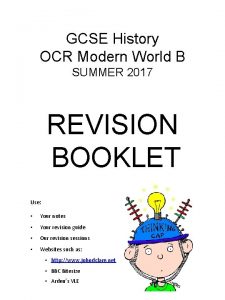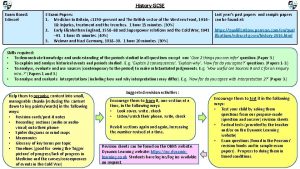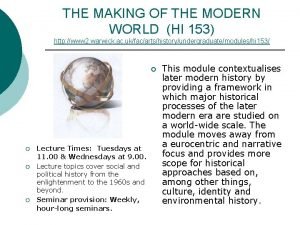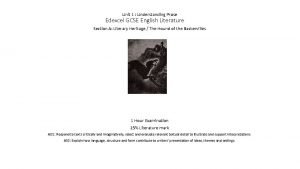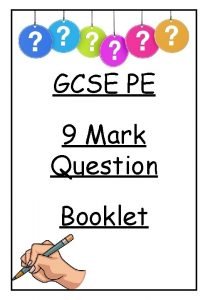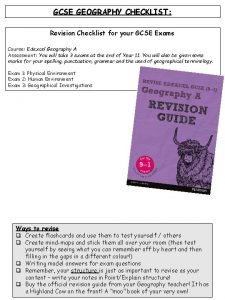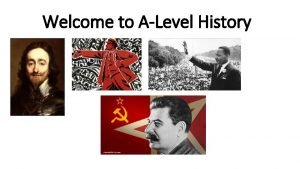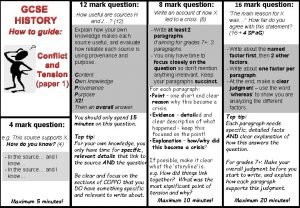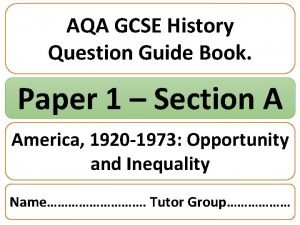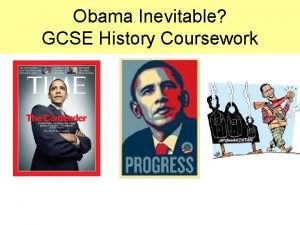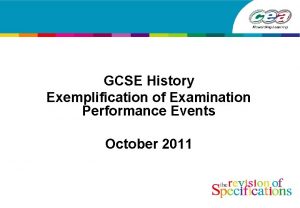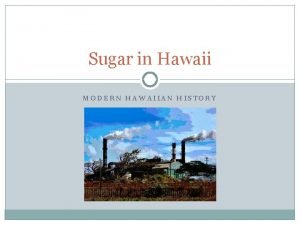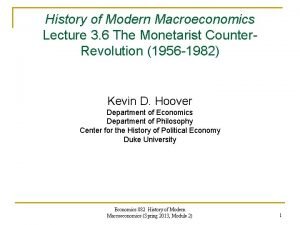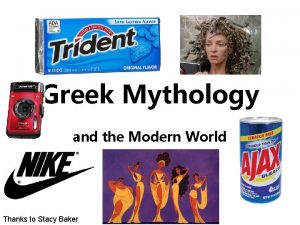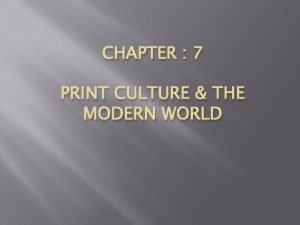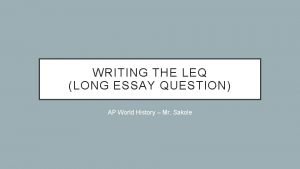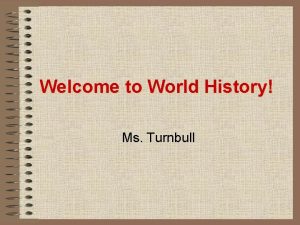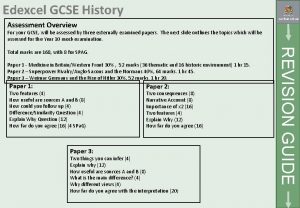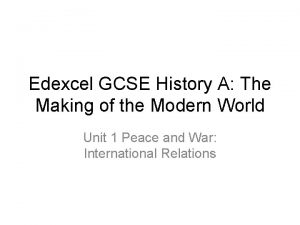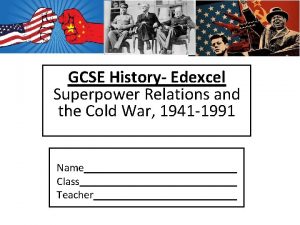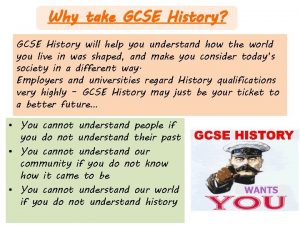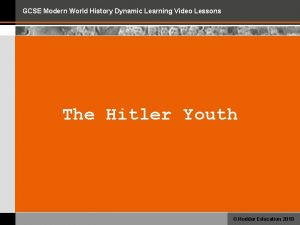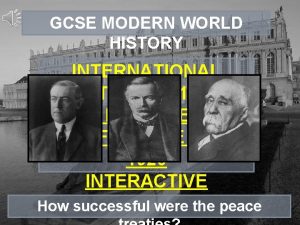Edexcel GCSE History Making of the Modern World









































































































- Slides: 105

Edexcel GCSE History – Making of the Modern World Year 10 Modern World Depth Study Germany 1918 -39 • The Weimar Republic 1918 -33 • Hitler and the growth of the Nazi Party 1918 -33 • The Nazi Dictatorship 1933 -39 • Nazi domestic policies 193339 Controlled Assessment Representations of History • America 1919 -41

Edexcel GCSE History – Making of the Modern World Source Enquiry War and the transformation of British society 19311951 • The impact of the Depression 1931 -39 • Britain at War • Labour in power 1945 -51

Edexcel GCSE History – Making of the Modern World Year 11 Peace and War: International Relations 1943 -1991 • How did the Cold War develop 1943 -56? • Three Cold War crises: Berlin, Cuba, Czechoslovakia 1957 -69 • Why did the Cold War end?

Unit 3 B – Britain 1931 -51 Key Topics 1. The impact of the Depression on Britain in the 1930 s 2. Britain at war 19391945 3. The Home Front 19391945 4. The Labour Party in power 1945 -51 Examination You will be given a collection of sources to study and then you will be asked 5 Q’s which will test your understanding of interpreting sources. 1. Inference 2. Purpose 3. Causation 4. Evaluating reliability 5. Evaluating a hypothesis.

Plan for Term 1 Lessons H/W Week 2 Unemployment in Britain in the 1930 s Making Inferences from sources Government Reactions Considering the purpose of sources Collect Germany H/W Week 3 Effects of unemployment Making inferences from sources Case Study – The Jarrow Crusade Week 4 Case Study – The Jarrow Crusade Explaining causation using source and own knowledge Week 5 Britain goes to war Blitzkrieg Week 6 Dunkirk Battle of Britain Week 7 D-Day Why did D-Day succeed? Week 8 Source paper D-Day Week 9 The defeat of Germany Create a summary sheet for Revision of Key Topic 1. Source Paper

Key Topic 1 – The impact of the Depression Unemployment in Britain in the 1930 s Success Criteria: Content: • To understand the levels and distribution of unemployment in Britain in the 1930 s Sources: • To make inferences from sources.

Key Topic 1 – The impact of the Depression Unemployment in Britain in the 1930 s Content Sources 1. Question 1 – Inference. Make a judgement about what the source says or shows. (6 marks) 10 mins 2. 3. 4. Which Industries and areas of Britain were badly affected by unemployment in the 1930 s? How badly was London and the South-East affected during the Depression? What different methods of protest were carried out by the unemployed? What was National Insurance Benefit? What was the Dole? Jarrow March 1. What can we learn about the Depression in the 1930 s by studying Source C? 2. What can we learn about unemployment in Britain in the 1930 s by examining Source D?

What to include in a 6 mark question Inference question (10 minutes) • Skills assessed: Comprehension and inference • To infer is to explain what something (in this case the source provided) implies or suggests and to reason from the evidence • Make sure you refer directly to the source, for example, from source A I can infer that….

Structure The first thing I can lnfer is …. . This is shown in the source where it says/shows …. Another thing I can infer is This is shown in the source where it says/shows…….

Key Topic 1 – The impact of the Depression Government reactions Success Criteria: Content: • To identify how the government tried to deal with the problems of unemployment Sources: • To consider the purpose of a source

Government reactions Problem Action taken by the National Government 1. Certain regions of the country were particularly badly affected by unemployment. 1934 Special Areas Act – 2. Only people in certain trades were eligible for unemployment benefit. 1930 Unemployment Insurance Act – 3. The government did not have enough money to pay benefit to everyone who wanted it. 1931 Means Test – 1937 Special Areas Amendment Act - 1934 Unemployment Act - Use the information from the para ‘the National Government’ on page 12 to fill in the chart above showing the action taken by the National Government.

Considering the purpose of a source Q 2 – What was the purpose of Source B? Use details from the poster and your own knowledge to explain your answer. (8 marks) 12 mins • What is the poster showing? • Why was it produced? • Use your own knowledge to explain the historical context

What was it like to be unemployed in the 1930 s? Success Criteria: Content • To describe the experiences of the unemployed in the 1930 s Sources • To select and use information from the sources • To practise a Q 1 – Inference. Activity Read the text and in pairs make a list/spider diagram of the effects of unemployment.

What was it like to be unemployed? Inference Q 1. Study Source B. What can we learn about the impact of unemployment on family life? (6 marks) 10 mins • 2 inferences supported by 2 bits of detail from the source.

‘The town that was murdered’ The Jarrow March Success Criteria: Content: • To describe the reasons for the Jarrow Crusade, how it was organised, opposition to it and the effects of the Crusade Sources • To practise a Q 3 – causation using source and own knowledge

Task: Research the Jarrow Crusade, using the questions below and pages 16 -20 as a guide. The Jarrow Crusade 5 th – 31 st October 1936 (300 miles)

This song was created in 1974 as a tribute to the Jarrow marchers • The Jarrow Song What does it tell us about the legacy of the Jarrow March?

Explaining causation using a source and own knowledge Q 3 – Use Source D on p. 19 and your own knowledge to explain why people supported the Jarrow March. (10 marks – 12 mins) • Select 2 reasons from the source. • Add your own knowledge to each reason to explain why there was so much support.

Key Topic 2 – Britain at War 1939 -45 Success Criteria: • To understand why War broke out in 1939 • To explain the role of Churchill as wartime Prime Minister • To evaluate speeches as historical evidence Can you explain why War broke out in 1939? § 11 th November 1918 § Treaty of Versailles § Adolf Hitler § Germany re-arms § Anschluss with Austria § Sudetenland & Czechoslovakia § Invasion of Poland § Policy of Appeasement § Britain and France declare War


Key Topic 2 – Britain at War 1939 -45 Success Criteria: • To understand why War broke out in 1939 • To explain the role of Churchill as wartime Prime Minister • To evaluate speeches as historical evidence Listen to the clip of Chamberlain addressing the British public Chamberlain declares war Now listen to Churchill addressing the British public We shall fight them on the Beaches How do the 2 speeches compare?

Key Topic 2 – Britain at War 1939 -45 Success Criteria: • To understand why War broke out in 1939 • To explain the role of Churchill as wartime Prime Minister • To evaluate speeches as historical evidence § Task: It is May 1940. Using the information on page 25 write a short radio broadcast to explain to the British public why Britain is fighting against Germany. It should Last no longer than 1 minute

Question 2 What was the purpose of this poster? Use details of the poster and your own knowledge to explain your answer. (8 marks – 12 mins) • What is the poster showing? • Why was it produced? • Use your own knowledge to explain the historical context

Blitzkrieg Success Criteria: • To describe what is meant by Blitzkrieg • To explain the effects of Blitzkrieg warfare • To select evidence to back up inferences. Activities 1. Write a definition of Blitzkrieg in your book 2. Why was it so successful? 3. Using sources A-D find evidence for the following inferences about Blitzkrieg a. It caused a lot of damage b. It scared people c. It was very successful

Dunkirk Starter Watch the following scene from a modern film about the Second World War. Write down all the words that pop into your head as you watch it. Atonement


Dunkirk Success Criteria: • To understand the importance of Dunkirk • To explain the reasons for British survival • To evaluate the purpose of paintings as historical evidence Dunkirk Activity - This painting by Charles Cundall was displayed in the National Gallery. Write an account of Dunkirk to explain why it was painted. Include details from the painting, the sources and your own knowledge.

Dunkirk § Situation in May 1940? § Operation Dynamo? § Why did some people see this event as a victory? § Why did Churchill call it a military disaster? § What is meant by ‘Dunkirk spirit? ’ § Why was this painting made? Activity - This painting by Charles Cundall was displayed in the National Gallery. Write an account of Dunkirk to explain why it was painted. Include details from the painting, the sources and your own knowledge.


The Battle of Britain Success Criteria: • To describe what the Battle of Britain was. • To explain why Britain won. • To evaluate sources by make inferences. Churchill – This was their finest hour

The Battle of Britain Content 1. What was the Battle of Britain? 2. Why did Britain win? Stuka V Spitfire Battle of Britain Climax Sources - Inferences What can you learn from Sources A, B & C about pilots in the Battle of Britain? Source A It suggests the pilots were well trained because It also infers the pilots that had good warning of the enemy coming because B C

Battle of Britain

How did the course of the War change in 1941?

D-Day Success Criteria: • To understand the events leading up to D-Day • To explain how D-Day was planned • To make inferences from the sources D-Day in colour

Hitler standing at the Trocadero, Paris By the end of 1941 Germany occupied large parts of Europe. Planning for D Day began when Stalin called for Great Britain and the USA to open a second front in Western Europe. The Russians had been doing the majority of the fighting against Germany and wanted the USA and Great Britain to launch an invasion in the West to ease the pressure on them.

The Supreme Command of the Allied Expeditionary Force These were the men in charge of the invasion of German-occupied France. The man seated in the middle is General Dwight D Eisenhower who was in overall charge. Later on he would become President of the United States of America between 1953 and 1961.

Choosing the landing beaches The first key decision was to choose the location of the invasion beaches. Planners collected postcards from people who had been to Normandy on holiday for photographic evidence as to what the coast looked like, but this photograph was taken from an aircraft. It was used to orientate the troops landing on this section of the coast, codenamed Sword Beach.

Diving suit To make sure the beaches could handle the weight of the tanks, trucks and other vehicles that would take part in the invasion, men were © sent ashore from submarines to collect samples of sand. This diving suit was used by Lieutenant Rollo Mangnall to reconnoitre the potential landing beaches.

The Atlantic Wall The Germans had built a large network of fortifications and beach defences along the coast of France. Dealing with these obstacles was one of the biggest problems for the planners of D Day. The defences shown in this photograph were designed to tear the bottom out of landing craft when concealed at high tide.

Code-named “Window” The Allies used various tactics to try and convince the Germans that the landings would be at Pas de Calais. This photo shows a factory worker producing foil, code-named “window”. “Window” was strips of aluminium which were dropped by aircraft in order to confuse German radar.

© IWM (B 5102) British troops going ashore at Sword Beach Tidal conditions and heavy defences on Sword Beach meant there was not much room to land. This caused the congestion of armoured vehicles that can be seen on the beach.

© IWM (A 23938) Canadians landing at Juno Beach Canadian troops landing in the Juno Beach area shortly before midday, 6 June 1944. The men are carrying bicycles to help them move inland quickly, without having to wait for heavier transport.

D-day Landing Craft


Mulberry Harbour Some equipment could be brought in across the beaches, but this would not be enough to sustain the huge numbers of men landing in France after D Day. Until such a time as a port could be captured, the Allies needed a method with which to land large quantities of material. A prefabricated harbour named Mulberry was designed and built in Britain and then towed across to Normandy where it provided shelter and moorings for supply ships.

D-day Mulberry Harbour

PLUTO (Pipe Line Under the Ocean) To provide enough fuel for the thousands of vehicles in France a plan was devised to lay a pipe under the sea and pump the petrol across from Britain. This photo shows the large drum of pipe called a ‘Conundrum’ ready to be laid on the sea floor.


D-Day Activities • When and why did the USA enter the War? • Explain why the USA were so keen for a quick invasion of Europe? How did the British respond to this idea? • Use the text and Source A to explain how the Allies planned for D-day. • Use the text, the map and the sources to explain the course of the D-day landings. * 5 th June * 6 th June * 7 th June * 25 th June

Why did D-Day succeed? Success Criteria: • • • To describe the reasons for D-Day’s success To analyse the sources for evidence of success To form a judgement about the most important reasons for success. Activity Use the text on p. 34 to make a list of all the reasons that explain why D-Day was a success.

Why did D-Day succeed? Source A B C D E Reasons for Success Evaluate the source – NOP. How reliable? An extract from a book about the Special Operations Executive, written in 1998. These were secret at the time so could not be written about until later.

The Defeat of Germany Success Criteria: • To explain the different reasons for Germany’s defeat in WW 2 • To analyse the sources for evidence of defeat Activity Write a conversation between 2 British people about the reasons for the defeat of Germany OR Write a radio speech for Churchill explaining to the British public how Germany has been defeated. Downfall Churchill - End of War

The Defeat of Germany Success Criteria: • To explain the different reasons for Germany’s defeat in WW 2 • To analyse the sources for evidence of defeat Exam Q 3 – Use Source C and your own knowledge to explain why Germany was defeated. (10 marks – 12 mins) One reason the Germans were defeated was because………………. This is shown in the source……………. Another reason the Germans were defeated was because………………. This is shown in the source……………. 8 marks – 1 explained factor 9 -10 marks - 2 or more explained factors

Plan for Term 2 Lessons H/W Week 1 Britain prepares for War Evacuation Practise Q 4 Revise Germany – 1 hr Week 2 The Blitz Practise Q 5 Revise Germany – 1 hr Week 3 New dangers The Ministry of Information Revise Britain – 1 hr Week 4 Mock Exam Week Rationing Working women Working Women after the war Week 5 Labour comes to power The Beveridge Report Revise Germany – 1 hr Week 6 Fighting giants Revise Germany – 1 hr Week 7 NHS Using the NHS

Preparing for War Success Criteria • To understand the need for government control during the war. • To describe how the Government prepared for attacks on Britain. • To explain how real was the threat of invasion. Starter – What on earth is happening in this picture?

Preparing for War Activity Use the text and the sources on P. 32 & 33 to list the different ways that Britain prepared for War Present your work as: • A mind map? • A spider diagram? • A list of bullet points? How did Britain prepare for WAR?

Air Raid Shelters

The Underground - London

Anderson Shelter

Morrison Shelter

Air Raid Wardens

Barrage Balloons

Blackout

The Home Guard

Anti-aircraft gun

Evacuation Success Criteria: • To understand what evacuation was and why it was necessary • To evaluate the reliability of sources – Q 4 Evacuation

Q 4 – How reliable are Sources A and B as evidence of how organised evacuation was? Explain your answer using Sources A and B and your own knowledge. (10 marks – 12 mins) • What does Source A show? • Is it reliable? Can you trust it? Does it back up what you already know? • What does Source B show? • Is it reliable? Can you trust it? Does it back up what you already know?

Plenary – Was the evacuation at the start of the war disruptive and unnecessary?

The Blitz 1940 -41 Success Criteria: • To understand the reasons for the Blitz on British cities. • To explain the effects of the Blitz on cities and citizens. • To practise the hypothesis Question. The Blitz in colour

What was the Blitz? When did it take place? Which cities were targeted and why? I What were the effects of the Blitz? Did the Blitz work?

Q 1 - What was the Blitz and when did it take place?

Q 2 – Which cities were targeted and why? Bristol and the Blitz Bristol WW 2

Q 3 – What were the effects of the Blitz?

Q 4 – Did the Blitz work?

The Blitz on Coventry

Q 5 – Source C suggests that British morale was not destroyed by the Blitz. How far do you agree with this interpretation? Use your own knowledge, Sources C, D and F and any other sources you find helpful to explain your answer. (16 marks –SPAG – 3 • What does Source C suggest? Use points from the source, evaluate it and add your own knowledge. • Do any of the other sources back up this interpretation? Use points from the source, evaluate it and add your own knowledge. • Which source(s) provide the counter-argument? Use points from the source, evaluate it and add your own knowledge.

New Dangers How did German bombing change after the Blitz? § Baedeker Raids § New bombs – V 1 s & V 2 s

The Baedeker raids

V 1 s & V 2 s

Britain at war Success Criteria • To understand how everyday life was affected by the war. • To explain the role of the government, the use of censorship and propaganda, the purpose of rationing and the role of women

Government Control The Ministry of Information • Use the text and the sources to explain the need for tighter control in wartime. • Use the text and the sources to explain the use of censorship and propaganda Britain at war Rationing Working Women • What was the impact of the war on the food supply and how did the government deal with it? • Use the text and the sources to explain the war work women did.


Q 5 – The Hypothesis Question (16 marks) 20 mins Source C suggests that after the war women were expected to just be housewives again. How far do you agree with this interpretation? Use Sources B, C and D, your own knowledge and any other sources you may find useful to explain your answer. Plan • What does Source C suggest? Use points from the source, evaluate it and add your own knowledge. • Do any of the other sources back up this interpretation? Use points from the source, evaluate it and add your own knowledge. • Which source(s) provide the counter -argument? Use points from the source, evaluate it and add your own knowledge. • Make a judgement and take into account the strength of the sources.

Revise Key Topic 3 – Britain at War Write your own questions to match the following answers: 1. 2. 3. 4. 5. 6. 7. 8. Rationing Blackout Ministry of Information Conscription Allies Operation Overlord 6 th June 1944 April 1945 Q 4 – Evaluation of utility or reliability How reliable are Sources A and D on p 46 & 47 as evidence of the restrictions imposed by the government in the Second World War? Explain your answer (10 marks) 12 mins § Are Sources A & D accurate? Do they back up what you already know? § Has anything been missed out? § Use the provenance – NOP. Can you fully trust who produced it?

Key Topic 4 – Labour in power 1945 -51 What are the different meanings Success Criteria: behind the V sign? • To describe the differences between the Conservative Party and the Labour Party in post war Britain • To explain the 1945 election campaigns of both parties. Post-War Britain

Churchill V Attlee 1945


General Election July 1945 Winston Churchill Party Beliefs Election Campaign Results Clement Attlee

General Election July 1945 Winston Churchill Party Beliefs Election Campaign Results Clement Attlee Activity – Conservative or Labour? • Preserving tradition. • Party of change. • Supported by the wealthy and landed classes. • Supported by the working class & trade unions. • Left-Wing – Socialist views • Right-Wing. • The importance of the Individual. • The importance of the State. • Higher Taxes. • Lower Taxes. • Private Industry • State control of Industry • More equal distribution of wealth.

General Election July 1945 Winston Churchill Party Beliefs Election Campaign Results Clement Attlee Activity – Election Campaign 1. What did the Conservative campaign focus on? 2. What did the Labour campaign focus on?

Starter - It is time to elect a new world leader, and only your vote counts. . Here are the facts about the three candidates. Candidate A: Associates with crooked politicians, and consults with astrologists. He's had two mistresses. He also chain smokes And drinks 8 to 10 martinis a day. Candidate B: He was kicked out of office twice, Sleeps until noon, Used opium in college And drinks a quart of whiskey every evening. Candidate C: He is a decorated war hero, He's a vegetarian, Doesn't smoke, Drinks an occasional beer And never committed adultery.

Candidate A is Franklin D. Roosevelt. Candidate B is Winston Churchill. Candidate C is Adolf Hitler.

The Beveridge Report Success Criteria: • To describe the main aims of the Beveridge Report. • To examine the sources for message and purpose. • To evaluate the Beveridge Report. Activities: 1. What was the Beveridge Report and what did it aim to tackle? 2. Inference Q – What can you learn from Source D about reactions to the Beveridge Report? 3. Design your own creative diagram to show legislation dealt with the 5 giants. 4. What is your opinion of the Beveridge Report?

A National Health Service Success Criteria: • To describe the planning of the NHS. • To explain why there was some opposition from the medical profession. • To evaluate the impact of the NHS up to 1951. Activity – Read through P. 7 O – 73 and design a colourful mind- map /spider diagram on the NHS.

A National Health Service Activities 1. What was Beveridge’s intention for the NHS? 2. What is the BMA and why did it oppose the NHS – use evidence from the sources? Exam Question How useful are Sources C and E as evidence of doctor’s opposition to the NHS? (10 marks) 12 mins. • What can we learn from C & E about opposition? • Evaluate the sources for strengths and weaknesses. - Consider NOP

Practise Exam Question – Using the NHS Q 5 – The hypothesis Question ‘The reason NHS costs were so high was because people misused it. ’ How far do the sources on pages 72 -73 support this statement? Use details from the sources and your own knowledge to explain your answer. (16 marks) 20 mins • Which sources support the view? • Which sources do not? • Consider the value of the sources • Form a judgement

Unemployment in the 30’s • Figures of unemployed? • Which industries / areas most affected? Government Reactions • Changes to the law Experiences of the Unemployed The Impact of the Depression Jarrow Crusade • Causes? • Organisation? • Opposition? Jarrow Crusade • The effects of public opinion Jarrow Crusade • Government reaction? • Gains from the march? • The Jarrow legacy?

Why Labour won the 1945 election The Beveridge Report and its importance The attack on the 5 giants. Especially ‘want’ Labour in power 1945 -51 Planning the NHS and opposition from the medical profession The impact of the NHS up to 1951

The Beveridge Report Success Criteria: To examine the social problems in post-war Britain. To evaluate the Beveridge Report. Activity –What does this clip tell us about poverty in Britain? The Beveridge Report

Desire for a more equal society The World Wars did create a demand desire for a society with greater equality between rich and poor? What reasons can you think of for this? How might the following things have contributed to this? : Rationing Evacuation

The Beveridge Report �Set up in 1941 �Led by Sir William Beveridge �Published report in 1942 �Said that the government needed to attack Five Giant “Evils”: Q -W �Squalor wa s t hat B �Ignorance eve he Re rid p �Want wh ort ge at and �Idleness aim did �Disease tac to it kle ?

Task 1 Stick your copy of the cartoon into your book. Use the information on P. 66 -69 to annotate each of the Five Giant Evils with what was done to attack them

Task 2 Examination Question – Inference What can you learn from Source D about reactions to the Beveridge report? (6 marks)

Plenary To what extent do you think these Five Giant Evils have been defeated in society? Do they exist today or not?

 How useful is this source
How useful is this source Edexcel history past papers
Edexcel history past papers Edexcel gcse history crime and punishment exam questions
Edexcel gcse history crime and punishment exam questions Making of the modern world warwick
Making of the modern world warwick Gcse art assessment objectives edexcel
Gcse art assessment objectives edexcel Edexcel gcse english literature
Edexcel gcse english literature Pie chart gcse
Pie chart gcse Edexcel gcse english language
Edexcel gcse english language Aqa gcse pe 9 mark question examples
Aqa gcse pe 9 mark question examples Edexcel gcse music set works
Edexcel gcse music set works Edexcel music gcse past papers
Edexcel music gcse past papers Edexcel gcse english language paper 2
Edexcel gcse english language paper 2 Edexcel gcse drama
Edexcel gcse drama Edexcel gcse pe specification
Edexcel gcse pe specification Edexcel english language paper 1 past papers
Edexcel english language paper 1 past papers Macbeth exam questions edexcel
Macbeth exam questions edexcel Aqa gcse geography revision checklist
Aqa gcse geography revision checklist Pearson unseen material
Pearson unseen material English language paper 2 edexcel
English language paper 2 edexcel Ap world history chapter 25 africa and the atlantic world
Ap world history chapter 25 africa and the atlantic world Dangerous world tour history world tour - hockenheimring
Dangerous world tour history world tour - hockenheimring Edexcel alevel history
Edexcel alevel history Gcse modern foreign languages
Gcse modern foreign languages What is inferring
What is inferring War making and state making as organized crime
War making and state making as organized crime How useful questions gcse history
How useful questions gcse history Aqa history gcse papers
Aqa history gcse papers Gcse history
Gcse history Gcse history coursework
Gcse history coursework Gcse history ccea
Gcse history ccea Hình ảnh bộ gõ cơ thể búng tay
Hình ảnh bộ gõ cơ thể búng tay Lp html
Lp html Bổ thể
Bổ thể Tỉ lệ cơ thể trẻ em
Tỉ lệ cơ thể trẻ em Gấu đi như thế nào
Gấu đi như thế nào Chụp phim tư thế worms-breton
Chụp phim tư thế worms-breton Chúa yêu trần thế
Chúa yêu trần thế Các môn thể thao bắt đầu bằng từ đua
Các môn thể thao bắt đầu bằng từ đua Thế nào là hệ số cao nhất
Thế nào là hệ số cao nhất Các châu lục và đại dương trên thế giới
Các châu lục và đại dương trên thế giới Công thức tiính động năng
Công thức tiính động năng Trời xanh đây là của chúng ta thể thơ
Trời xanh đây là của chúng ta thể thơ Cách giải mật thư tọa độ
Cách giải mật thư tọa độ 101012 bằng
101012 bằng độ dài liên kết
độ dài liên kết Các châu lục và đại dương trên thế giới
Các châu lục và đại dương trên thế giới Thơ thất ngôn tứ tuyệt đường luật
Thơ thất ngôn tứ tuyệt đường luật Quá trình desamine hóa có thể tạo ra
Quá trình desamine hóa có thể tạo ra Một số thể thơ truyền thống
Một số thể thơ truyền thống Cái miệng xinh xinh thế chỉ nói điều hay thôi
Cái miệng xinh xinh thế chỉ nói điều hay thôi Vẽ hình chiếu vuông góc của vật thể sau
Vẽ hình chiếu vuông góc của vật thể sau Biện pháp chống mỏi cơ
Biện pháp chống mỏi cơ đặc điểm cơ thể của người tối cổ
đặc điểm cơ thể của người tối cổ Giọng cùng tên là
Giọng cùng tên là Vẽ hình chiếu đứng bằng cạnh của vật thể
Vẽ hình chiếu đứng bằng cạnh của vật thể Vẽ hình chiếu vuông góc của vật thể sau
Vẽ hình chiếu vuông góc của vật thể sau Thẻ vin
Thẻ vin đại từ thay thế
đại từ thay thế điện thế nghỉ
điện thế nghỉ Tư thế ngồi viết
Tư thế ngồi viết Diễn thế sinh thái là
Diễn thế sinh thái là Các loại đột biến cấu trúc nhiễm sắc thể
Các loại đột biến cấu trúc nhiễm sắc thể Số.nguyên tố
Số.nguyên tố Tư thế ngồi viết
Tư thế ngồi viết Lời thề hippocrates
Lời thề hippocrates Thiếu nhi thế giới liên hoan
Thiếu nhi thế giới liên hoan ưu thế lai là gì
ưu thế lai là gì Hươu thường đẻ mỗi lứa mấy con
Hươu thường đẻ mỗi lứa mấy con Sự nuôi và dạy con của hổ
Sự nuôi và dạy con của hổ Sơ đồ cơ thể người
Sơ đồ cơ thể người Từ ngữ thể hiện lòng nhân hậu
Từ ngữ thể hiện lòng nhân hậu Thế nào là mạng điện lắp đặt kiểu nổi
Thế nào là mạng điện lắp đặt kiểu nổi History of sugar timeline
History of sugar timeline Brief history of modern dance
Brief history of modern dance Ancient egypt floral design
Ancient egypt floral design French floral design history
French floral design history Egyptian floral history
Egyptian floral history Modern history
Modern history Modern history
Modern history History of modern portfolio theory
History of modern portfolio theory Modern medicine in ethiopia
Modern medicine in ethiopia Challenges of christianity in the modern world
Challenges of christianity in the modern world Print culture and the modern world
Print culture and the modern world What is language in mathematics in the modern world
What is language in mathematics in the modern world Greek mythology in the modern world
Greek mythology in the modern world Modern world youtube
Modern world youtube Print culture and the modern world
Print culture and the modern world Psyche definition psychology
Psyche definition psychology Modern world
Modern world Also history physical
Also history physical Leq prompts ap world
Leq prompts ap world Total war world history definition
Total war world history definition Chapter 17 section 3 luther leads the reformation
Chapter 17 section 3 luther leads the reformation World history spring final exam review answers
World history spring final exam review answers Ap world history jeopardy
Ap world history jeopardy Chapter 32 assessment world history
Chapter 32 assessment world history Chapter 30 section 2 world history
Chapter 30 section 2 world history What was the counter-reformation?
What was the counter-reformation? World geography spring final review
World geography spring final review Manorial system ap world history
Manorial system ap world history Ms turnbull history
Ms turnbull history Prince henry the navigator ap world history
Prince henry the navigator ap world history Scientific revolution ap world history
Scientific revolution ap world history Chapter 16 lesson 1 the protestant reformation
Chapter 16 lesson 1 the protestant reformation Chapter 13 ways of the world notes
Chapter 13 ways of the world notes Climate change definition ap world history
Climate change definition ap world history
